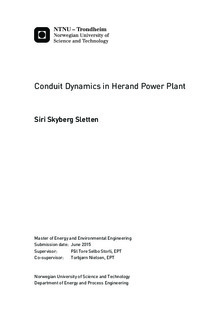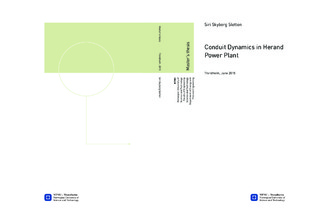| dc.description.abstract | The aim of this master thesis was to conduct a stability analysis of Herand power plant. Herand is a hydropower plant under planning by Herand Kraft, and it is planned to have a generator of 27MVA. The size of the power plant puts it under the requirements in Norway stating that all generators above 10MVA must have frequency regulation and be able to operate in an isolated grid. This paper presents a conducted analysis of Herand that examines whether the plant will be able to meet these requirements, and maintain a stable regulation system.
The conducted analysis was based on control theory. A block diagram was set up from differential equations for each element in Herand power plant. The transfer function of the system was found, and by the use of Simulink and Matlab, as well as an analytical approach, the Amplitude - Phase - Frequency (APF) diagrams were found. The focus in the analysis was three dynamic aspects; the mass oscillations between inlet and air cushion surge chamber, water hammer occuring in the penstock following a regulation when including the elastic property of the penstock, and regulation stability.
The challenge for Herand when it comes to obtaining acceptable frequency regulation is concerning the topography at the location. The penstock will be long, and an air cushion surge chamber will be implemented upstream of the turbine to enhance stability. An objective of this paper was to find the optimal dimensions of the air cushion surge chamber, and to examine whether Herand then will have acceptable regulation stability.
The conducted simulations showed that Herand power plant will have a stable regulation system when implementing an air cushion surge chamber. The elastic frequency will lie above the crossover frequency, hence the controller will not attempt to regulate the pressure surges. The system will be unstable without an air cushion surge chamber. The Thoma critical area was calculated to find the minimum required surface area of the air cushion that will result in stable mass oscillations. The total volume of the air cushion surge chamber used in the simulations was 712.26m3. Up- and downsurge from the air cushion surge chamber was also avoided with the calculated volume. | |

